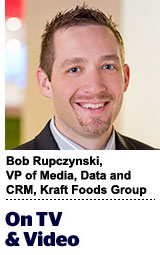 Today marks the debut of “On TV & Video,” a new column exploring opportunities and challenges in programmatic TV and video.
Today marks the debut of “On TV & Video,” a new column exploring opportunities and challenges in programmatic TV and video.
Today’s column is written by Bob Rupczynski, vice president of media, data and CRM at Kraft Foods Group.
As I continue hearing about the tremendous progress we have made in programmatic television, I can’t help but think back to the moments in time when programmatic changed everything else in life.
I think back to 1940, when the first programmatic Oldsmobile hit the market. I reflect on the life-changing programmatic channel changer Zenith released in 1950 called the Lazy Bone or, as it’s more commonly known today, the remote control. Or even all the way back to 1439, when Gutenberg invented the first programmatic moveable-type press. Programmatic has really been a game-changing wave that has swept history.
You are probably thinking that those things have nothing to do with programmatic. Yet all over our industry, people are talking about programmatic without really understanding what it means. The word and concept have been manipulated to stand for any technology that links people and information (programmatic Excel?) to legitimate automated capabilities for buying data-decisioned media.
Are we ready for programmatic TV ad buying? Technically, yes. But first we should figure out what exactly we’re trying to achieve.
Is It Programmatic?
I was recently asked what is all the hype about programmatic and whether it is just a blip or trend. My answer: The strategic move toward data-driven marketing is the right path to increased marketing precision and effectiveness. It is not a trend, but a significant advancement toward better marketing.
The rampant overuse of the word programmatic to mean any form of automation or bidding on remnant inventory, however, is a short-term fad.
In order to help standardize the language and create clarity and consistency in our expectations, here are three key requirements points for programmatic. Aligning on the meaning will focus all efforts so that we can move forward toward the actual goal, rather than distracting and delaying progress with a deluge of premature new releases and buzzy pronouncements.
Programmatic is data-driven. It is imperative to include some level of data within your programmatic infrastructure that allows for informed decisions.
This inherently leads to another key element of a programmatic buy: addressability, or the ability to create distinct segments in order to reach relevant targets with an appropriately tailored message.
Finally, there needs to be an aspect of real-time agility to the buying process. This does not necessarily correlate to a biddable environment, but it does mean the decisioning is being transacted in real time.
It is important to note however, that this automation without the other core elements of the equation cannot equate to a programmatic buy. If it were that easy, we could start calling our coffee makers “programmatic Java producers.”
Is It Programmatic TV?
It is difficult enough to understand how these elements are used and applied in digital. Now the industry claims to have also brought them together in linear television. A programmatic linear TV buy? Each month news releases trumpet that someone has bought television programmatically. The trade press picks it up and runs with it without fact checking. All of a sudden, it’s shared and retweeted. Everyone pops the Champagne. We’ve arrived. It’s done!
Is it possible? Technically, yes. Technically, we could use data to create specific addressable segments and apply them to a real-time automated environment. I haven’t seen that it has actually happened yet. But the core question with programmatic linear television is whether that is indeed the end goal, or if the future for linear TV is really data-decisioned addressability.
In reality, linear television doesn’t resemble digital media. There are important differences that profoundly change the market dynamics. Linear television, despite the explosion of cable networks, still has finite and limited premium inventory. As a result, inventory is sold upfront to legacy advertisers who enjoy significant rate advantages. These advantages are lost in the scatter market and would be fully erased in an open bid environment.
Programmatic linear TV would also require a massive infrastructure build on the part of the networks, which is unlikely to be undertaken given the rapid shift to streaming and OTT we are seeing. We’ll arrive in programmatic premium online video (OLV) world before we get to programmatic linear TV. And that’s fine.
Overall, the video industry is progressing. Digital is eclipsing “traditional media” on numerous fronts. OLV is finally at parity with linear, from both a quality and availability standpoint. Automation and even programmatic are coming to digital video. Addressable is finally a reality within linear television, thanks to partners like Comcast, DirecTV and Dish. Addressable automation is a welcome early exploration within the linear/local world.
I couldn’t be more excited to be a part of this industry and help to drive the foundational shift that is rocking the traditional world. However, we need to stop taking a victory lap one-third of the way to the destination. It both cheapens the prize and distracts from the promise.
We are not yet where we want or need to go as an industry, so it’s time to collectively keep the pressure on with the actual end goal in mind. We’re not there yet.
Follow Bob Rupczynski (@rupp), Kraft Foods Group (@kraftfoods) and AdExchanger (@adexchanger) on Twitter.












